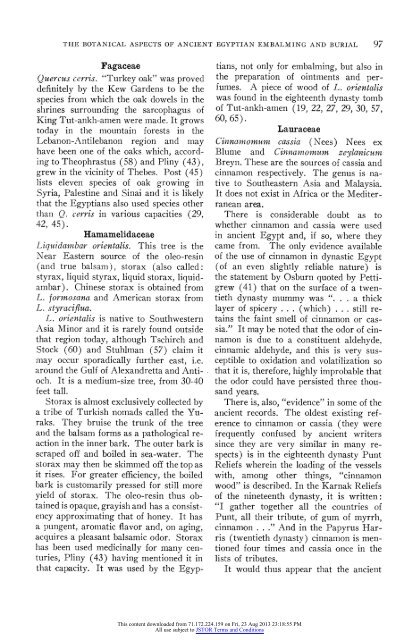The Botanical Aspects of Ancient Egyptian Embalming and Burial
The Botanical Aspects of Ancient Egyptian Embalming and Burial
The Botanical Aspects of Ancient Egyptian Embalming and Burial
Create successful ePaper yourself
Turn your PDF publications into a flip-book with our unique Google optimized e-Paper software.
THE BOTANICAL ASPECTS OF ANCIENT EGYPTIAN EMBALMING AND BURIAL 97<br />
Fagaceae<br />
Quercus cerris. "Turkey oak" was proved<br />
(lefinitely by the Kew Gardens to be the<br />
species from which the oak dowels in the<br />
shrines surrounding the sarcophagus <strong>of</strong><br />
King Tut-ankh-amen were made. It grows<br />
today in the mountain forests in the<br />
Lebanon-Antilebanon region <strong>and</strong> may<br />
have been one <strong>of</strong> the oaks which, according<br />
to <strong>The</strong>ophrastus (58) <strong>and</strong> Pliny (43),<br />
grew in the vicinity <strong>of</strong> <strong>The</strong>bes. Post (45)<br />
lists eleven species <strong>of</strong> oak growing in<br />
Syria, Palestine <strong>and</strong> Sinai <strong>and</strong> it is likely<br />
that the <strong>Egyptian</strong>s also used species other<br />
than Q. cerris in various capacities (29,<br />
42, 45).<br />
Hamamelidaceae<br />
Liquidambar orientalis. This tree is the<br />
Near Eastern source <strong>of</strong> the oleo-resin<br />
(anld true balsam), storax (also called:<br />
styrax, liquid styrax, liquid storax, liquidambar).<br />
Chinese storax is obtained from<br />
L. formosana <strong>and</strong> American storax from<br />
L. styraciflua.<br />
L. orientalis is native to Southwestern<br />
Asia Minor <strong>and</strong> it is rarely found outside<br />
that region today, although Tschirch <strong>and</strong><br />
Stock (60) <strong>and</strong> Stuhlman (57) claim it<br />
may occur sporadically further east, i.e.<br />
around the Gulf <strong>of</strong> Alex<strong>and</strong>retta <strong>and</strong> Antioch.<br />
It is a medium-size tree, from 30-40<br />
feet tall.<br />
Storax is almost exclusively collected by<br />
a tribe <strong>of</strong> Turkish nomads called the Yuraks.<br />
<strong>The</strong>y bruise the trunk <strong>of</strong> the tree<br />
<strong>and</strong> the balsam forms as a pathological reaction<br />
in the inner bark. <strong>The</strong> outer bark is<br />
scraped <strong>of</strong>f <strong>and</strong> boiled in sea-water. <strong>The</strong><br />
storax may theni be skimmed <strong>of</strong>f the top as<br />
it rises. For greater efficiency, the boiled<br />
bark is customarily pressed for still more<br />
yield <strong>of</strong> storax. <strong>The</strong> oleo-resin thus obtained<br />
is opaque, grayish <strong>and</strong> has a consistency<br />
approximating that <strong>of</strong> honey. It has<br />
a pungent, aromatic flavor <strong>and</strong>, on aging,<br />
acquires a pleasant balsamic odor. Storax<br />
has been used medicinally for many centuries,<br />
Pliny (43) having mentioned it in<br />
that capacity. It was used by the Egyp-<br />
tians, not only for embalming, but also in<br />
the preparation <strong>of</strong> ointments <strong>and</strong> perfumes.<br />
A piece <strong>of</strong> wood <strong>of</strong> L. orientalis<br />
was found in the eighteenth dynasty tomb<br />
<strong>of</strong> Tut-ankh-amen (19, 22, 27, 29, 30, 57,<br />
60, 65).<br />
Lauraceae<br />
Cinnamomum cassia (Nees) Nees ex<br />
Blunmie <strong>and</strong> Cinnawomum zeyla:nicumn<br />
Breyn. <strong>The</strong>se are the sources <strong>of</strong> cassia <strong>and</strong><br />
cinnamon respectively. <strong>The</strong> genus is native<br />
to Southeastern Asia <strong>and</strong> Malaysia.<br />
It does not exist in Africa or the Mediterranean<br />
area.<br />
<strong>The</strong>re is considerable doubt as to<br />
whether cinnamon <strong>and</strong> cassia were used<br />
in ancient Egypt <strong>and</strong>, if so, where they<br />
came from. <strong>The</strong> only evidence available<br />
<strong>of</strong> the use <strong>of</strong> cinnamon in dynastic Egypt<br />
(<strong>of</strong> an even slightly reliable nature) is<br />
the statement by Osburn quoted by Pettigrew<br />
(41) that on the surface <strong>of</strong> a twentieth<br />
dynasty mummy was ". . . a thick<br />
layer <strong>of</strong> spicery . . . (which) . . . still retains<br />
the faint smell <strong>of</strong> cinnamon or cassia."<br />
It may be noted that the odor <strong>of</strong> cinnamon<br />
is due to a constituent aldehyde,<br />
cinnamic aldehyde, <strong>and</strong> this is very susceptible<br />
to oxidation <strong>and</strong> volatilization so<br />
that it is, therefore, highly improbable that<br />
the odor could have persisted three thous<strong>and</strong><br />
years.<br />
<strong>The</strong>re is, also, "evidence" in some <strong>of</strong> the<br />
ancient records. <strong>The</strong> oldest existing reference<br />
to cinnamon or cassia (they were<br />
frequently confused by ancient writers<br />
since they are very similar in many respects)<br />
is in the eighteenth dynasty Punt<br />
Reliefs wherein the loading <strong>of</strong> the vessels<br />
with, among other things, "cinnamon<br />
wood" is described. In the Karnak Reliefs<br />
<strong>of</strong> the nineteenth dynasty, it is written:<br />
"I gather together all the countries <strong>of</strong><br />
Punt, all their tribute, <strong>of</strong> gum <strong>of</strong> myrrh,<br />
cinnamon . . ." And in the Papyrus Harris<br />
(twentieth dynasty) cinnamon is mentioned<br />
four times <strong>and</strong> cassia once in the<br />
lists <strong>of</strong> tributes.<br />
It would thus appear that the ancient<br />
This content downloaded from 71.172.224.159 on Fri, 23 Aug 2013 23:18:55 PM<br />
All use subject to JSTOR Terms <strong>and</strong> Conditions
















